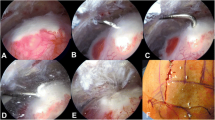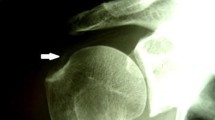Abstract
Background
Additional pathologies accompanying calcific tendinitis of the rotator cuff still remain unknown. The hypothesis of this study was that there are various additional pathologies accompanying calcific tendinitis, which might need further treatment. This study aimed to document intra-articular pathologies and investigate whether the location and spread of calcific tendinitis are associated with intra-articular pathologies and impairment in range of motion.
Methods
Arthroscopy was performed on 53 patients for chronic calcific tendinitis. Documentation included demographic baseline variables, intraoperative findings of all structures in the glenohumeral joint, range of motion, joint laxity under general anesthesia, and basic details of intraoperative procedures.
Results
In all, 189 additional pathologies were found, 77 during intra-articular arthroscopy. Of all extra- and intra-articular pathologies, 74 and 70%, respectively, required surgical treatment. A mean of 3.6 additional pathologic findings per patient were observed; 19% of all patients had multiple (i. e., ≥2) calcific spots. The main additional pathologies were bursitis (87%), type II–III acromion (Bigliani classification, 70%), and synovitis (47%). No statistical significance was found for any associations tested between the localization of the deposit and the documented pathologies.
Conclusion
Patients with symptomatic, chronic calcific tendinitis of the shoulder may suffer from multiple and therapeutically relevant disorders of the glenohumeral joint requiring surgical care. The frequency of findings underlines the importance of a diagnostic and therapeutic arthroscopy of the shoulder in order to ensure that surgeons properly address intra-articular pathologies.
Zusammenfassung
Hintergrund
Mögliche Begleitbefunde der Tendinosis calcarea des Schultergelenkes sind bis dato nicht ausreichend geklärt. Die Hypothese der vorliegenden Studie lautet, dass zahlreiche Begleitbefunde bei einer Tendinosis calcarea vorliegen dürften, welche ebenfalls therapiebedürftig seien. Zielsetzung dieser Studie war die Dokumentation intraartikulärer pathologischer Veränderungen und die Untersuchung möglicher Korrelationen der Lage und Verteilung der Kalkdepots mit intraartikulären Veränderungen sowie Bewegungseinschränkungen.
Methoden
Aufgrund einer chronischen Tendinosis calcarea wurden 53 Patienten arthroskopisch therapiert. Die Dokumentation umfasste demographische Basisvariablen der Patienten, intraoperative Befunde aller Strukturen des Glenohumeralgelenks, passive Bewegungsumfänge, Instabilitätszeichen in Allgemeinnarkose sowie Grundinformationen zum intraoperativen Vorgehen.
Ergebnisse
Es wurden 189 pathologische Veränderungen entdeckt, 77 während der Arthroskopie. Chirurgisch therapiert wurden 74 % aller (extra- und intra-) bzw. 70 % der intraartikulären Befunde. Im Mittel wurden 3,6 zusätzliche pathologische Veränderungen pro Patient dokumentiert. Bei 19 % der Patienten bestanden mehrere (≥2) kalzifizierende Herde. Die häufigsten begleitenden Veränderungen waren Bursitis (87 %), ein Akromion vom Typ II–III (Bigliani-Klassifikation, 70 %) oder Synovialitis (47 %). Es wurde kein statistisch signifikanter Zusammenhang zwischen der Kalklokalisation und den dokumentierten Begleitbefunden festgestellt.
Schlussfolgerung
Patienten mit symptomatischer chronischer Tendinosis calcarea können multiple und therapeutisch relevante Begleitverletzungen aufweisen, welche eine chirurgische Therapie notwendig machen. Dies unterstreicht den Stellenwert der Arthroskopie bei diesem Krankheitsbild.



Similar content being viewed by others
References
Ark JW, Flock TJ, Flatow EL, Bigliani LU (1992) Arthroscopic treatment of calcific tendinitis of the shoulder. Arthroscopy 8(2):183–188
Balke M, Bielefeld R, Schmidt C, Dedy N, Liem D (2012) Calcifying tendinitis of the shoulder: midterm results after arthroscopic treatment. Am J Sports Med 40(3):657–661. https://doi.org/10.1177/0363546511430202
Bigliani LU, Ticker JB, Flatow EL, Soslowsky LJ, Mow VC (1991) The relationship of acromial architecture to rotator cuff disease. Clin Sports Med 10(4):823–838
Daecke W, Kusnierczak D, Loew M (2002) Extracorporeal shockwave therapy (ESWT) in tendinosis calcarea of the rotator cuff. Long-term results and efficacy. Orthopäde 31(7):645–651. https://doi.org/10.1007/s00132-002-0324-y
Ellman H (1990) Diagnosis and treatment of incomplete rotator cuff tears. Clin Orthop Relat Res 25(4):64–74
Fernandes MR (2013) Arthroscopic capsular release for refractory shoulder stiffness. Rev Assoc Med Bras 59(4):347–353. https://doi.org/10.1016/j.ramb.2013.02.004
Gartner J, Heyer A (1995) Calcific tendinitis of the shoulder. Orthopäde 24(3):284–302
Gschwend N, Patte D, Zippel J (1972) Therapy of calcific tendinitis of the shoulder. Arch Orthop Unfallchir 73(2):120–135
Habermeyer P, Krieter C, Tang KL, Lichtenberg S, Magosch P (2008) A new arthroscopic classification of articular-sided supraspinatus footprint lesions: a prospective comparison with Snyder’s and Ellman’s classification. J Shoulder Elbow Surg 17(6):909–913. https://doi.org/10.1016/j.jse.2008.06.007
Harvie P, Pollard TC, Carr AJ (2007) Calcific tendinitis: natural history and association with endocrine disorders. J Shoulder Elbow Surg 16(2):169–173. https://doi.org/10.1016/j.jse.2006.06.007
Ishii H, Brunet JA, Welsh RP, Uhthoff HK (1997) “Bursal reactions” in rotator cuff tearing, the impingement syndrome, and calcifying tendinitis. J Shoulder Elbow Surg 6(2):131–136
Kachewar SG, Kulkarni DS (2013) Calcific tendinitis of the rotator cuff: a review. J Clin Diagn Res 7(7):1482–1485. https://doi.org/10.7860/JCDR/2013/4473.3180
Kircher J, Morhard M, Patzer T, Magosch P, Lichtenberg S, Habermeyer P (2012) Do anatomic variants of the acromion shape in the frontal plane influence pain and function in calcifying tendinitis of the shoulder? Knee Surg Sports Traumatol Arthrosc 20(2):368–372. https://doi.org/10.1007/s00167-011-1563-4
Loew M, Sabo D, Wehrle M, Mau H (1996) Relationship between calcifying tendinitis and subacromial impingement: a prospective radiography and magnetic resonance imaging study. J Shoulder Elbow Surg 5(4):314–319
Lorbach O, Trennheuser C, Anagnostakos K (2014) Diagnostics and therapy of isolated proximal biceps lesions. Obere Extremität 9(1):10–16. https://doi.org/10.1007/s11678-013-0243-z
Louwerens JK, Sierevelt IN, van Noort A, van den Bekerom MP (2014) Evidence for minimally invasive therapies in the management of chronic calcific tendinopathy of the rotator cuff: a systematic review and meta-analysis. J Shoulder Elbow Surg 23(8):1240–1249. https://doi.org/10.1016/j.jse.2014.02.002
Maier M, Krauter T, Pellengahr C, Schulz CU, Trouillier H, Anetzberger H, Refior HJ (2002) Open surgical procedures in calcifying tendinitis of the shoulder—concomitant pathologies affect clinical outcome. Z Orthop Ihre Grenzgeb 140(6):656–661. https://doi.org/10.1055/s-2002-36033
Marder RA, Heiden EA, Kim S (2011) Calcific tendonitis of the shoulder: is subacromial decompression in combination with removal of the calcific deposit beneficial? J Shoulder Elbow Surg 20(6):955–960. https://doi.org/10.1016/j.jse.2010.10.038
McLaughlin HL (1963) The selection of calcium deposits for operation; the technique and results of operation. Surg Clin North Am 43:1501–1504
Oliva F, Via AG, Maffulli N (2011) Calcific tendinopathy of the rotator cuff tendons. Sports Med Arthrosc 19(3):237–243. https://doi.org/10.1097/JSA.0b013e318225bc5f
Prato N, Peloso D, Franconeri A, Tegaldo G, Ravera GB, Silvestri E, Derchi LE (1998) The anterior tilt of the acromion: radiographic evaluation and correlation with shoulder diseases. Eur Radiol 8(9):1639–1646. https://doi.org/10.1007/s003300050602
Rebuzzi E, Coletti N, Schiavetti S, Giusto F (2008) Arthroscopy surgery versus shock wave therapy for chronic calcifying tendinitis of the shoulder. J Orthop Traumatol 9(4):179–185. https://doi.org/10.1007/s10195-008-0024-4
Sansone VC, Meroni R, Boria P, Pisani S, Maiorano E (2014) Are occupational repetitive movements of the upper arm associated with rotator cuff calcific tendinopathies? Rheumatol Int. https://doi.org/10.1007/s00296-014-3086-z
Snyder SJ, Karzel RP, Del Pizzo W, Ferkel RD, Friedman MJ (1990) SLAP lesions of the shoulder. Arthroscopy 6(4):274–279
Uhthoff HK, Loehr JW (1997) Calcific tendinopathy of the rotator cuff: pathogenesis, diagnosis, and management. J Am Acad Orthop Surg 5(4):183–191
Vavken P, Holinka J, Rompe JD, Dorotka R (2009) Focused extracorporeal shock wave therapy in calcifying tendinitis of the shoulder: a meta-analysis. Sports Health 1(2):137–144. https://doi.org/10.1177/1941738108331197
Yoo JC, Park WH, Koh KH, Kim SM (2010) Arthroscopic treatment of chronic calcific tendinitis with complete removal and rotator cuff tendon repair. Knee Surg Sports Traumatol Arthrosc 18(12):1694–1699. https://doi.org/10.1007/s00167-010-1067-7
Acknowledgements
The authors thank Prof. Peter Habermeyer for performing some of the surgeries and for supporting the study. The authors thank Dr. Roland Ventura for scientific advice.
Author information
Authors and Affiliations
Corresponding author
Ethics declarations
Conflict of interest
S.M. Hünnebeck, D. Stengel, S. Lichtenberg, C. Güthoff, and M. Loew declare that they have no competing interests.
All procedures followed were in accordance with the ethical standards of the responsible committee on human experimentation and with the Helsinki Declaration of 1975. Informed consent was obtained from all patients included in the study. Ethical committee approval was received by the ethical committee of the ATOS Clinic Heidelberg, no. 5/14.
Rights and permissions
About this article
Cite this article
Hünnebeck, S.M., Stengel, D., Lichtenberg, S. et al. Intra-articular findings in shoulder joints affected by calcific tendinitis. Obere Extremität 12, 242–247 (2017). https://doi.org/10.1007/s11678-017-0429-x
Received:
Accepted:
Published:
Issue Date:
DOI: https://doi.org/10.1007/s11678-017-0429-x




